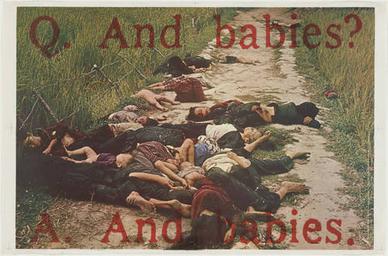
Back رونالد ال. هايبيرل ARZ Рональд Хэберлі Byelorussian Ronald Haeberle German Ronald Haeberle French Хэберли, Рональд Russian
Ronald L. Haeberle | |
|---|---|
 | |
| Born | c. 1941 |
| Occupation | U.S. Army photographer |
| Years active | 1966 - 1968 |
| Known for | Photographs taken at the scene of the Mỹ Lai Massacre |
| Title | Sergeant (SGT), Information Office, 11th Infantry Brigade (31st Public Information Detachment)[1]: p.770 |
Ronald L. Haeberle (born c. 1941) is a former United States Army combat photographer best known for the photographs he took of the My Lai Massacre on March 16, 1968. The photographs were definitive evidence of a massacre, making it impossible for the U.S. Army or government to ignore or cover up.[2] On November 21, 1969, the day after the photographs were first published in Haeberle's hometown newspaper, The Cleveland Plain Dealer, Melvin Laird, the Secretary of Defense, discussed them with Henry Kissinger who was at the time National Security Advisor to President Richard Nixon. Laird was recorded as saying that while he would like "to sweep it under the rug," the photographs prevented it.[3][4][5]
At the time of the massacre, Haeberle was a sergeant assigned as public information photographer to Charlie Company, 1st Battalion, 20th Infantry Regiment. With him were three cameras: two Army issued black and white cameras for official photos and his own personal camera containing color slide film.[6] It was the color photographs he took that day that provided evidence of the massacre and elevated the story of My Lai to world-wide prominence.[7] A year after Haeberle returned to his hometown of Cleveland, Ohio with an honorable discharge, he offered them to The Cleveland Plain Dealer, which published a number of them along with his personal account on November 20, 1969.[8] He then sold the photos to LIFE magazine, which published them in the December 5, 1969, issue.[7]

One of Haeberle's photos became an iconic symbol of the massacre, in large part because of its use in the And babies poster, which was distributed around the world, reproduced in newspapers, and used in protest marches.[9] Even though there were many other massacres by U.S. forces during the war, this image and Mỹ Lai itself came to represent them all.[10][11]
- ^ Investigations, United States. Congress. House. Committee on Armed Services. Armed Services Investigating Subcommittee (1976). Investigation of the My Lai Incident, Ninety-First Congress, Second Session. U.S. Government Printing Office.
- ^ Theiss, Evelyn (2018-03-15). "The Photographer Who Showed the World What Really Happened at My Lai". Time. Retrieved 2023-06-11.
When Haeberle's shocking photographs of their atrocities were published — more than a year later — the pictures laid bare an appalling truth: American "boys" were as capable of unbridled savagery as any soldiers, anywhere.
- ^ Becker, Elizabeth (2004-05-27). "Kissinger Tapes Describe Crises, War and Stark Photos of Abuse". The New York Times. ISSN 0362-4331. Retrieved 2019-10-16.
In their conversation on Nov. 21, 1969, about the My Lai massacre, Mr. Laird told Mr. Kissinger that while he would like to sweep it under the rug, the photographs prevented it.There are so many kids just laying there; these pictures are authentic, Mr. Laird said.
- ^ Oliver, Kendrick (2006). The My Lai Massacre in American History and Memory. Manchester University Press. pp. 36&39. ISBN 9780719068911.
Feher himself recalled that he did not obtain 'hard evidence that something real bad had happened' until he interviewed Ronald Haeberle on 25 August and was shown Haeberle's photographs of the massacre victims.(p.36) ...the interview indicated to Pentagon officials that news of the massacre could not be contained."(p.39)
- ^ Belknap, Michael R. (2002). The Vietnam War on Trial: The My Lai Massacre and the Court-Martial of Lieutenant Calley. University Press of Kansas. pp. 112&140. ISBN 9780700612116.
- ^ Investigations, United States. Congress. House. Committee on Armed Services. Armed Services Investigating Subcommittee (1976). Investigation of the My Lai Incident, Ninety-First Congress, Second Session. U.S. Government Printing Office. p. 267.
Mr. Stratton: You said that you had two black and white cameras and one color camera. Mr. Haeberle: That is right.
- ^ a b Cosgrove, Ben (1969-12-05). "American Atrocity: Remembering My Lai". LIFE. Retrieved 2023-06-11.
Incredibly, the world at large might have never learned about the death and torture visited by American troops upon the villagers at My Lai had it not been for an Army photographer named Ron Haeberle.
- ^ Corrigan, Jo Ellen (2009-11-20). "Plain Dealer exclusive in 1969: My Lai massacre photos by Ronald Haeberle". The Plain Dealer. Retrieved 2023-06-11.
- ^ M. Paul Holsinger (1999). "And Babies". War and American Popular Culture. Greenwood Press. p. 363. ISBN 9780313299087.
The Vietnam War produced thousands of shocking photographs of death and destruction, but few scenes were more disturbing than the horrific color picture of dozens of dead South Vietnamese women and children taken by combat photographer Ronald Haeberle
- ^ Turse, Nick (2013-08-28). "Was My Lai just one of many massacres in Vietnam War?". bbc.com. BBC News Service. Retrieved 2023-06-22.
The result was industrial-scale slaughter, the equivalent, he said, to a 'My Lai each month'.
- ^ Matthew Israel (2013). Kill for Peace: American Artists Against the Vietnam War. University of Texas Press. p. 130.
© MMXXIII Rich X Search. We shall prevail. All rights reserved. Rich X Search